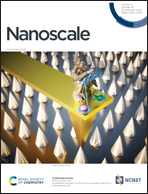In situ electrochemistry inside a TEM with controlled mass transport†
Abstract
The field of electrochemistry promises solutions for the future energy crisis and environmental deterioration by developing optimized batteries, fuel-cells and catalysts. Combined with in situ transmission electron microscopy (TEM), it can reveal functional and structural changes. A drawback of this relatively young field is lack of reproducibility in controlling the liquid environment while retaining the imaging and analytical capabilities. Here, a platform for in situ electrochemical studies inside a TEM with a pressure-driven flow is presented, with the capability to control the flow direction and to ensure the liquid will always pass through the region of interest. As a result, the system offers the opportunity to define the mass transport and control the electric potential, giving access to the full kinetics of the redox reaction. In order to show the benefits of the system, copper dendrites are electrodeposited and show reliable electric potential control. Next, their morphology is changed by tuning the mass transport conditions. Finally, at a liquid thickness of approximately 100 nm, the diffraction pattern revealed the 〈1,1,1〉 planes of the copper crystals, indicating an atomic resolution down to 2.15 Å. Such control of the liquid thickness enabled elemental mapping, allowing us to distinguish the spatial distribution of different elements in liquid.



 Please wait while we load your content...
Please wait while we load your content...